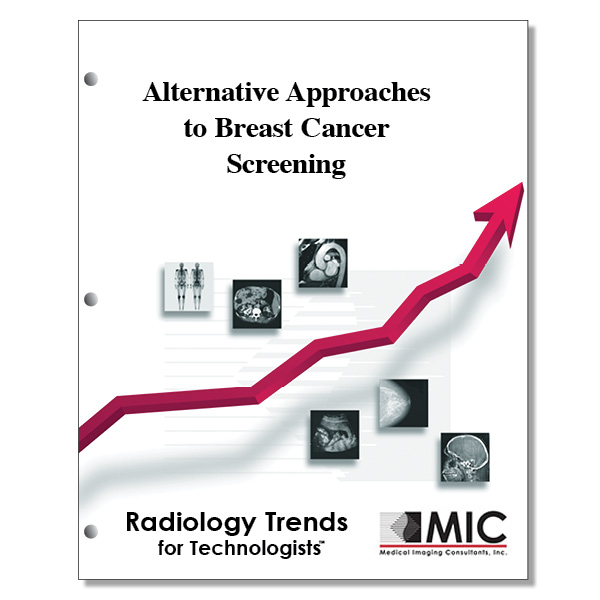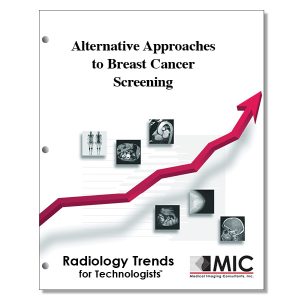

Alternative Approaches to Breast Cancer Screening
A review of emerging techniques in breast cancer screening using mammography, ultrasound, magnetic resonance imaging, and nuclear medicine.
Course ID: Q00663 Category: Radiology Trends for Technologists Modalities: Mammography, MRI, Nuclear Medicine, PET, Radiation Therapy, Sonography2.75 |
Satisfaction Guarantee |
$29.00
- Targeted CE
- Outline
- Objectives
Targeted CE per ARRT’s Discipline, Category, and Subcategory classification:
[Note: Discipline-specific Targeted CE credits may be less than the total Category A credits approved for this course.]
Breast Sonography: 2.00
Patient Care: 2.00
Patient Interactions and Management: 2.00
Mammography: 2.00
Procedures: 2.00
Mammographic Positioning, Special Needs, and Imaging Procedures: 2.00
Magnetic Resonance Imaging: 1.00
Patient Care: 0.50
Patient Interactions and Management: 0.50
Procedures: 0.50
Body: 0.50
Nuclear Medicine Technology: 1.00
Patient Care: 0.50
Patient Interactions and Management: 0.50
Procedures: 0.50
Endocrine and Oncology Procedures: 0.50
Registered Radiologist Assistant: 2.00
Procedures: 2.00
Thoracic Section: 2.00
Sonography: 1.00
Patient Care: 0.50
Patient Interactions and Management: 0.50
Procedures: 0.50
Superficial Structures and Other Sonographic Procedures: 0.50
Radiation Therapy: 2.00
Patient Care: 2.00
Patient and Medical Record Management: 2.00
Outline
- Introduction
- Mammography
- Digital Breast Tomosynthesis
- Contrast Material-Enhanced Spectral Mammography
- US Examination
- Microvascular Imaging
- Elastography
- Automated Breast US
- US Transmission Tomography
- Optoacoustic US
- Fusion Imaging
- MRI Examination
- Abbreviated Breast MRI
- Ultrafast Breast MRI
- Diffusion-Weighted Imaging
- Nuclear Medicine Techniques
- MBI Examination
- Breast PET Imaging
- Artificial Intelligence and Machine Learning
- Non-Imaging Novel Screening Techniques
- Conclusion
Objectives
Upon completion of this course, students will:
- be familiar with the basic facts about DBT
- know the advantages of combining DBT with DM
- be familiar with potential results of ongoing technologic advances in DBT algorithms
- understand the requirements for contrast-enhanced spectral mammography
- know how most contrast-enhanced spectral mammography compares with breast MRI
- know a common criticism of breast ultrasound
- be familiar with the roles, advantages, and disadvantages of the various breast ultrasound techniques
- know the basics of Doppler ultrasound
- be familiar with the advantages of microvascular ultrasound imaging
- know how elastography improves ultrasound specificity and sensitivity
- know the similarities and differences between strain and 2D shear wave elastography
- know how the addition of elastography and Doppler benefits screening with B-mode ultrasound
- recognize the advantages of automated breast ultrasound
- know why enthusiasm for automated breast ultrasound as a supplemental screening modality has been hampered
- identify the basic components of the transmission tomography ultrasound technique
- know how the speed of sound map is dependent on the density of various tissues
- be familiar with the basic facts and uses of optoacoustic ultrasound
- understand the need for and usefulness of fusion imaging
- recognize the reasons why breast MRI is not used for population-wide screening
- know the ACR accreditation requirements for breast MRI
- know the necessary sequences for an abbreviated breast MRI protocol
- understand how abbreviated breast MRI protocols compared with full breast MRI protocols in the multi-study review cited in the article
- be familiar with the potential causes for the lower-than-expected gains in patient flow rate for abbreviated MRI examinations
- know what ultrafast breast MRI can help to document in breast cancer cases
- understand the benefit of ultrafast breast MRI when added to abbreviated breast MRI protocols
- know what diffusion-weighted images can help to demonstrate and how they can benefit breast imaging
- know the benefits of dual-panel, CZT MBI systems over single-panel, breast-specific gamma imaging systems using either sodium or cesium iodide crystals
- be familiar with the basics of MBI protocol and 99mTc Sestamibi uptake
- know the patient population(s) for which MBI is a good supplemental screening exam
- know the patient and imaging preparation steps for 18F-FDG PET imaging
- be familiar with the current limitations on the utility of breast PET imaging for widespread screening
- be familiar with the average supplemental cancer detection rates of the various vascular-based screening techniques
- be familiar with the clinical roles for AI use in the various breast imaging modality options
- understand why deep learning algorithm research has focused on screening mammography
- be familiar with where AI is currently focused in breast ultrasound and what benefits may be obtained
- understand why AI can deliver both lesion classification and lesion detection in automated breast ultrasound
- understand how the use of MRI radiomics benefits patients
- know how an acceptable sensitivity is currently achieved for deep learning-based automated detection algorithms for MRI breast cancer screening
- know what debris growing cancers actively or passively shed into the bloodstream
- understand the potential benefits of liquid biopsy assessment for breast cancer patients
